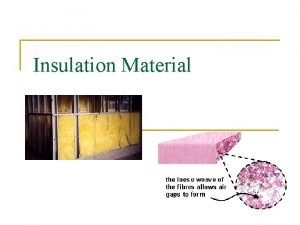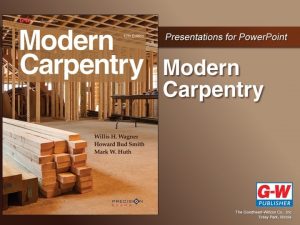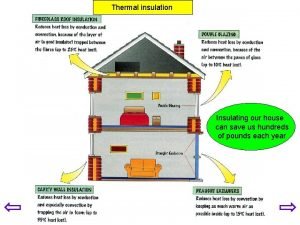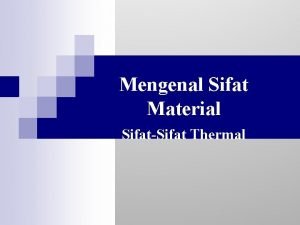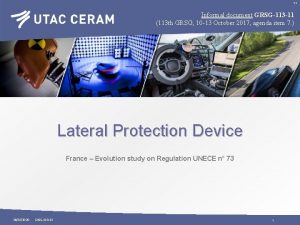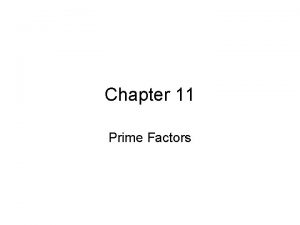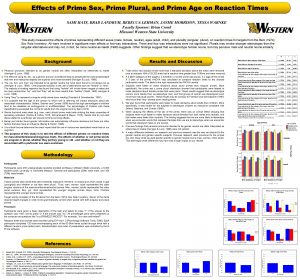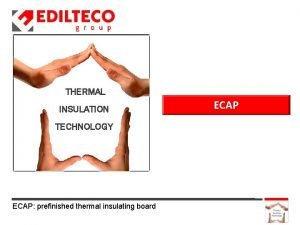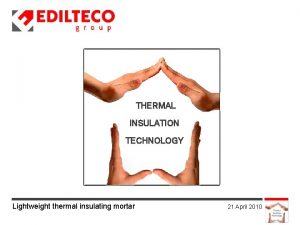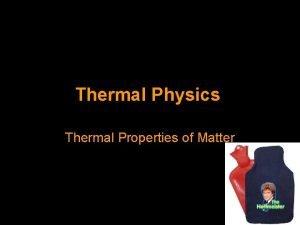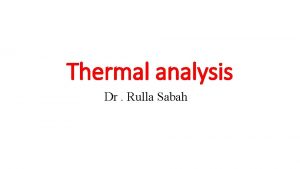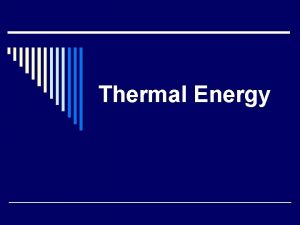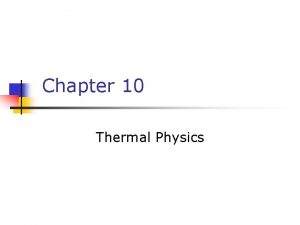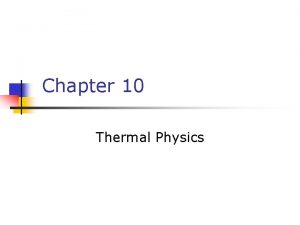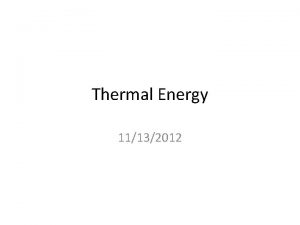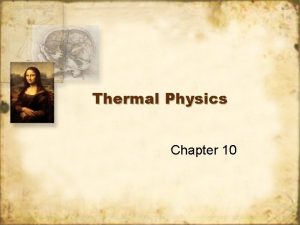Insulation Material Thermal Insulation n The prime concern


















- Slides: 18

Insulation Material

Thermal Insulation n The prime concern of building designers today is to ensure that the occupants and the equipment that they use will function at peak efficiency and comfort, and yet use the minimum amount of energy

Heat Transfer n n Transfer of heat always occurs from warm to cool. In structures a stable temperature is ideal which produces to situations q q Winter-energy must be used to maintain a comfortable temperature- without proper insulation heat is lost to the colder outside air. Summer – the building interior must be cooled to keep it comfortable. The less insulation that is used the greater are the costs for air-conditioning.

Heat Transfer n Heat is transferred in three ways q q q Conduction Convection Radiation

Heat Transfer n Conduction q q q When a wall panel is subjected to a temperature differentiate, the wall feels cool to the touch on the warm side. The reason for this is that the inside heat is being conducted from the warmer side to the cooler side. To prevent heat loss by conduction, materials that are poor conductors of heat must be used. Usually the less dense the material the better the resistance to heat loss by conduction.

Heat Transfer n Convection q q q Air that is heated expands and rises As the air rises it comes in contact with cooler surface and energy is given up To minimize this effect air spaces should be kept relatively shallow – not over 1 in. and be divided into small enclosed compartments.

Heat Transfer n Radiation q q Heat that is absorbed by a wall panel will be radiated to the surrounding cooler air. One way to reduce the amount of radiated heat is to use reflective surfaces to prevent the absorption of heat

Thermal Properties n n Thermal Conductivity k Conductance C Thermal resistance R Thermal Transmittance u

Thermal Properties n Thermal conductivity k – this is the term used to indicate the amount of heat that will pass through a unit of area of a material at a temperature difference of one degree. The lower the K value the better the insulation qualities of the material.

Thermal Properties n Conductance – C –Conductance indicates the amount of heat that passes through a given thickness of material q Conductance = thermal conductivity/thickness

Thermal Properties n Thermal Resistance – R – Thermal resistance is the property of material that resists the flow of heat through the material. Resistance is the reciprocal of conductance q q R = 1/c The total thermal resistance of a building system is the sum of the individual thermal resistances of the materials used to make up the system.

Thermal Properties n Thermal Transmittance – u – thermal transmittance is the amount of heat that passes through all the materials in a system. It is the reciprocal of the total resistance q U = 1/R

Kinds of Thermal Insulation n All materials used to prevent heat losses are known as thermal insulation. q Loose Fill – loose fill insulating is generally bulky and can be divided into two main types. n n q Blanket insulation – is made from fibrous materials, such as mineral wool, wood fiber, cotton fiber, or animal hair. n q Fibrous – made from mineral wool – rock, glass, or slag wool, or vegetable fiber – usually wood fiber Granular – are made from expanded minerals such as perlite and vermiculite. Made in mats in various thickness and sometimes cover with paper cover. Batts – batts are similar in basic manufacture to blankets, but they are restricted as to length usually 4 ft.

Kinds of Thermal Insulation n Structural insulation boards – made from a variety of substances, such as cane, wood, and mineral fibers. Used as exterior or interior sheathing, insulating roof decking. Slab insulation – is made in rigid units, normally smaller in are than insulation board, made from cork, shredded wood and cement, mineral wool. Reflective insulation – are composed of metallic or other special surfaces with or without backing. Relies on surface characterizes, thickness of air space to determine insulation value.

Kinds of Thermal Insulation n Sprayed on insulation – produced by mixing some fibrous or cellular material with an adhesive and blowing the mixture onto the surface to be insulated. Foamed in place insulation – made from synthetic liquid resins. Two ingredients are used which, when mixed produce a foam which solidifies to fill the space. Corrugated insulation – made from paper, . Corrugated and cemented into multiple layers.

Vapor Insulation n n The dampness that sometimes occurs inside buildings can be caused by penetration of moisture from the outside or by condensation of water vapor generated on the inside. Vapor Barriers q q A materials which effectively retard or stop the flow of warm, moisture-laden air from inside a building outward through walls, ceilings and floors to the colder, dryer outside atmosphere. Should be installed on the warm side of the insulation

Types of Vapor Barriers n n n Polyethylene film Aluminum foil Coated kraft paper Outside Temp Vapor barrier paint -18 Moisture vapor control Inside relative humidity 20 -18 to -7 30 -7 and over 40

Moisture Barriers n Which are used to prevent the entrance of moisture into a building from the outside.
 Prime concern
Prime concern Sempatap
Sempatap Chapter 17 thermal and sound insulation
Chapter 17 thermal and sound insulation How are houses insulated
How are houses insulated Section 3 using heat worksheet answers
Section 3 using heat worksheet answers Thermal transfer vs direct thermal printing
Thermal transfer vs direct thermal printing Sage flow meters
Sage flow meters Jeff bezos prime video prime
Jeff bezos prime video prime Sifat thermal material
Sifat thermal material Sifat thermal material
Sifat thermal material What is real culture
What is real culture Geometric symbols and their meanings
Geometric symbols and their meanings Useful or harmful
Useful or harmful Non material culture examples
Non material culture examples Material price variance formula
Material price variance formula Examples of popular culture
Examples of popular culture Why is water pollution of great concern in southwest asia
Why is water pollution of great concern in southwest asia The going concern assumption assumes that the business
The going concern assumption assumes that the business Growing concern grade 11, 1150l
Growing concern grade 11, 1150l
